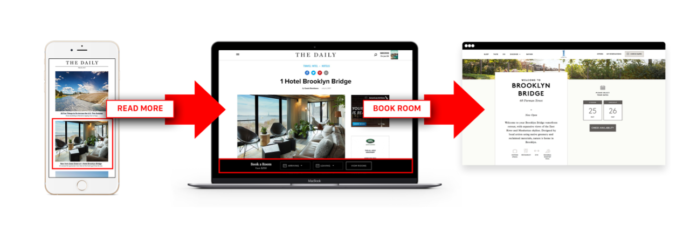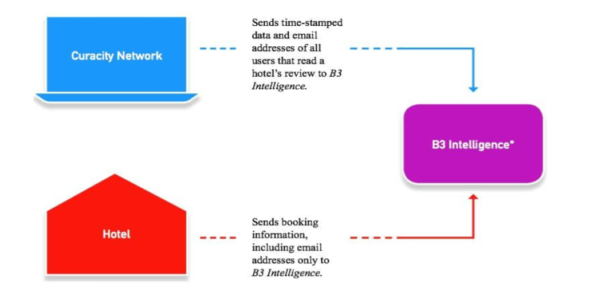
Is click attribution technology the future of travel media?
By cameron in Uncategorized
Travel media, like traditional publishers, has had a challenging time transitioning to digital. Many advertisers are moving advertising spend from offline to online, changing the fundamental economics for travel publishers.
For advertisers, the proliferation of publishers has made it quite challenging to correctly identify and target the correct demographics.
In addition to hyper-targeting, analytics is one of the driving factors behind the shift to digital. Calculating true return-on-investment becomes more attainable with the ability to track a consumer’s click journey, from inspiration to shopping to booking.
Publishers are in a sweet spot when it comes to digital marketing: the content consumed by readers very often leads to an actual purchase. And in travel, these bookings can be worth a lot of money.
This is where technology can play a pivotal role. By attributing clicks to a specific conversion, technology can make it possible for content to be measured as far as its impact on the purchase funnel.
A new partnership between lauded travel publisher AFAR Media, and content technology company Curacity, highlights how content can be properly attributed to its influence throughout the purchase funnel.
Beyond the benefits of additional revenue, this new insight into content inputs new data into the publishing process. By writing editorial content that converts, the publisher can balance its commercial ambitions with its trusted editorial voice.

In an interview, Mike Keriakos, the CEO of Curacity, and Joe Diaz, the co-founder of AFAR Media, shared how this partnership evolved — and what it means for hotel marketers looking to engage AFAR’s digital readers.
What is Curacity?
Mike: Curacity is a content and data-driven platform for publishers and the hotels they write about. Curacity serves its publishers and hotels by measuring and monetizing consumers that book hotel rooms after viewing editorial content.
Using proprietary technology, these products help hotels reach travelers at the critical point of inspiration while enabling publishers like AFAR Media to earn OTA-like commissions for hotel bookings catalyzed by their content within a 12-month window.
What does this mean for AFAR Media as a publisher?
Joe: It’s twofold. The most obvious is that we can create a new revenue stream from sharing commissions. In addition, we can begin to better understand the role our content plays in moving travelers from inspiration to action, learn, and iterate.
The partnership aligns perfectly with our mission of inspiring, guiding, and enabling travelers to have deeper, richer, and more fulfilling experiences.
From the perspective of a publisher, working with Curacity gives us the ability to expose the inequality of last click attribution, which enables the large OTA’s to take a lion’s share of the commissions for very little work, and give more credit to the publishers who do a lot of influencing and guiding earlier in the travel planning process.

Content is produced across Curacity’s publishing partners’ sites, and then amplified to each partner’s audience. Articles link directly to hotel websites.
Mike: Curacity has gone from a pilot with SurfaceHotels.com, an owned-and-operated site reaching two-hundred thousand people per month, to a network publishing partners that now reaches 10 million people per month, in just one year.
AFAR Media is our largest publisher to date, and it is a milestone moment as it has opened the gateway to demonstrate to the C-suite of luxury hotels that content amplification by trusted publishers is a channel that can drive big revenue.

Data files from publishers and hotels are encrypted, and sent to Curacity’s third-party data analytics firm to uncover overlap between people that read content and book as a direct result.
What does this mean for hotel marketers?
Mike: AFAR Media is a world-class travel publication and an innovative brand on the forefront of what’s new and lasting in the travel industry. We couldn’t be happier to have them join the Curacity network. From their audience alone, we increase our reach 50%. The AFAR partnership allows Curacity hotel partners to reach up to ten million travelers monthly.
A core thesis of marketing is that companies will be at the mercy of distributions channels if there isn’t an investment in creating demand. To no fault of their own, luxury hotel marketers haven’t been given the tools to efficiently create their own demand.
Continuing to do business as usual via OTAs, they exacerbate this issue, increasing the leverage that these OTAs have over their own hotel brands.
Curacity provides hotel marketers with their own demand-generation engine, providing the tools for hotels to break the leverage that OTAs maintain.
What does this mean for readers?
Joe: This is very good news for readers. Think about it…a publisher can only create world-class content when they can monetize their investment. Allowing revenue to flow from hotel marketers to publishers, helps fuel our publishers’ ability to go even deeper on hotel coverage both from a breadth and depth of coverage.
What trends does this partnership emphasize/highlight?
Mike: Hotels are looking for platforms that break their dependence on OTAs’ increasing commissions. Curacity provides a solution to invest in demand, loosening the grip OTAs have on their businesses.
Publishers are realizing that their one-stop CPM solutions are not working well for all classes of advertisers and they are seeking new revenue streams.
Looking ahead, what are the benchmarks you will be tracking to measure the success of this partnership?
Mike: We’d like to facilitate hotel partnerships with every hotel that AFAR Media includes on their influential Recommended List of hotels.
We’re building a network that, once at scale, will drive hundreds of thousands of dollars in incremental bookings for each of those hotels, and provide those commissions to AFAR.
We will declare victory when our hotel partners tell us that our efforts have transformed their ability to reduce—or remove entirely—their reliance on OTAs.
We would like to see commissions at Priceline and Expedia drop in half or less when the OTA is simply fulfilling an order instead of actually creating new demand. In short, once we set this marketing ecosystem straight and hear that OTAs are getting paid only for the demand they create vs demand they intercept, our jobs will be done.
Photo by Harpal Singh on Unsplash
![]()

